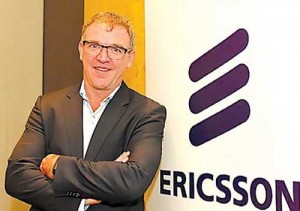IT’S practically the end of 2015, and Sean Gowran says he has a lot to be thankful for. After all, 2015 has been a very good year for his company, and prospects are even brighter in the coming years. Gowran is the new chief of Ericsson Philippines and Pacific Islands, and as is the company’s usual practice he held a year-end briefing on the results of their newest study and trends in the coming years.
In particular, the Ericsson Philippines’ chief executive says their findings in the latest edition of the Ericsson Southeast Asia and Oceania regional Mobility Report show that by 2018 the LTE subscriptions will grow to around 40 percent of the total mobile subscriptions in the Philippines. The report indicated that by the 2121 more than 75 percent of the people in the region will have access to LTE networks. In the Philippines, Gowran points out that “smartphone subscription penetration is estimated at around 40 percent, and we see this growing to around 70 percent by 2018. UN data states that the urban population of the Philippines is at 44 percent level, so we can expect that by 2018, smartphone subscription will exceed the urban population.”
The data is quite significant to Ericsson’s businesses in the region, including the Philippines, because of the huge investments the multinational has made here. As the fifth largest software company in the world, Ericsson is one of the world’s oldest companies, evolving from a Swedish telegraph equipment repair shop in 1876 to one of the world’s leading provider of technology services to telecom operators.
In the Philippines, Ericsson had helped local telecom companies build the infrastructure for the supply, design and implementation of Smart’s TACS network, Smart and Sun Cellular’s LEC network. They were also responsible for Smart’s LTE rollout for Northern and Southern Luzon. At the same time, they were a major partner for PLDT’s Zero Backlog Program. In 1999, Ericsson did the Globe GSM Network expansion projects for the Visayas and Mindanao. The company also counts the major television networks in the country, specifically ABS-CBN and ABC5 as their customers. Apart from all that, the company also undertook the LTE rollout of Digicel Pacific’s network in Papua New Guinea.
The company also offers support solutions by developing and delivering software-based solutions for operations and business support systems (OSS and BSS), real-time multi-screen and on demand TV and Media solutions, as well as solutions and services for the emerging M-commerce that include banking and remittances.
Gowran says an important takeaway from the report is that “we can see that 3 of the top 10 growth markets for the 3rd quarter, are markets in our region, and this means we have significant subscriber growth, significant technology uptake in the increase of smartphone users (both 3G and 4G) — and that is being forecasted to further increase. The total number of subscribers in the region is now at slightly over 1 billion.”
Of course, he says the industry would have to overcome key challenges they are currently experiencing, as well as improvements they need to have in place in anticipation of the continued rise of smartphones and growth in data usage. Ericsson’s report shows the total mobile data traffic in the region is seen to increase 14-fold by 2121. This means more consumers are migrating to higher data volume packages. But what is clear is that 40 percent of Philippine consumers utilize less than 50 percent of their plan allocation, while 20 percent of consumers use more than 100 percent of their allocation. Gowran says consumers who underutilize their subscription packages will have a lower perception of the value for money of the package from the service provider, and may lead to a churn — the percentage of subscribers to a service that discontinue their subscription).
Gowran, who is Irish, says he is very much at home in Asia, having been assigned to China and Taiwan in the last 10 years. He says he and his family are quite happy and excited to be in the Philippines, as they love to explore the many beaches and dive resorts the country has to offer. He revealed that he and his wife are both dive instructors and their passion is shared by their two young daughters. They have been traveling to the Philippines as a family even before he was re-assigned to head Ericsson Philippines. Gowran says he is lucky that his family has been used to a lifestyle of traveling to wherever his work assignments take him. Ask any of his kids where their home is, he says, and their answer is usually “home is where we live.” And he adds, that’s how it should be. After all, their original home might be in Ireland and Sweden, but they have embraced different cultures as part of who they are as a family, and consider themselves rightly, as true citizens of the world.


